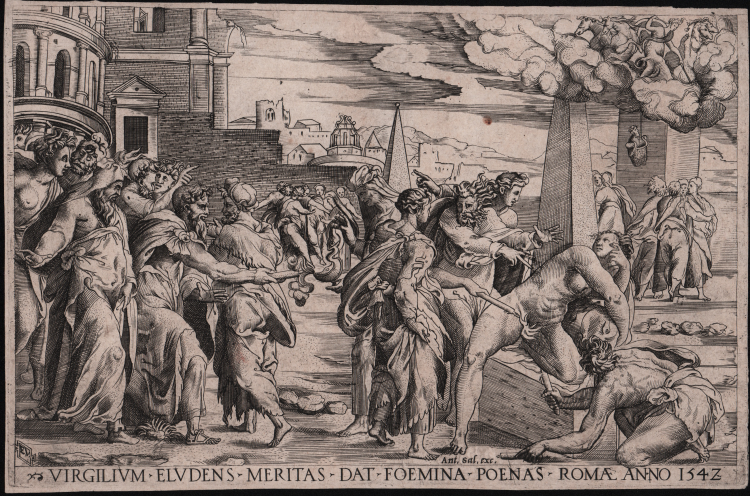




| Reference: | S42780 |
| Author | Enea VICO |
| Year: | 1542 |
| Measures: | 280 x 185 mm |



| Reference: | S42780 |
| Author | Enea VICO |
| Year: | 1542 |
| Measures: | 280 x 185 mm |
Engraving, signed with monogram on a tablet lower left: 'EV', inscribed and dated in the margin: 'VIRGILIVM ELVDENS MERITAS DAT FOEMINA POENAS ROMAE ANNO 1542'. Inscrideb with Antonio Salamanca excudit, lower centre in the image “Ant. sal. exc.” Possibly after after Francesco Salviati or Perin del Vaga.
Example in the second final state, with Salamanca imprint. A fine impression, printed with tone on contemporary laid paper with “hand” watermark, trimmed to the platemark or with narrow margins, a small spot in the upper center, otherwise very good condition.
A favourite subject at this time with the painter-engravers was the poet, or as he was considered in the middle ages, the magician, Virgil, suspended in a basket. The story is a curious one. Virigl becomes a magician at an early age, and performs wonderful things; but he falls in love with a lade in Rome who pretends to be ready to receive him, and lowers a great basket for that purpose; but when half-way up to her window ties the suspending rope at leaves him to be laughed at by the market people in the morning. Vergil, to revene himself, extinguishes by magic all the fires in Rome, and renders it impossible to procure even light, till, forced by the Kaiser to rectify the mischief, he demands that the lady should appear naked on a pedestal, the only means of obtaining fire again being from her body.
Enea Vico (Parma 1523 - Ferrara 1567) was an engraver and numismatist. Settled very young in Rome, he worked for publishers-merchants of prints such as Tommaso Barlacchi and Antonio Salamanca and trained mainly through the study of copperplate engravings of Marcantonio Raimondi and his school. After a stay in Florence (1545) settled in Venice and then move, from 1563, the court of Alfonso II in Ferrara. There are about five hundred engravings of Vico: portraits, series of ancient vases, gems and cameos, engravings of works by Raphael, Michelangelo, Salviati, etc..; the collection Le immagini delle donne auguste (taken from Roman medals, 1557). His fame as a numismatist is confirmed by the volumes Immagini con tutti i riversi trovato et le vite degli imperatori (1548); Discorsi sopra le medaglie degli antichi (1555); Commentari alle antiche medaglie degli imperatori romani (1560).
Bibliografia
Bartsch XV.304.46; Gori Gandinelli, V, pp. 49-50; TIB.30.65.46; Borea 1980, pp. 271-72; Barryte 2015, app. 467.
Enea VICO (Parma 1523 - Ferrara 1567)
|
Enea, son of Francesco, was antique dealer, drawer, engraver and numismatist. He was born in Parma on January 29th, 1523, according to what Huber says. After the first school years in the city, and very likely after he made acquaintance with the works of Giulio Romano, Vico moved to Rome in 1541. He then worked for Tommaso Barlacchi, who also engraved with him a series of Grottesche, in 1542. In the classical atmosphere of Rome, Vico’s style developed according to that of Perin del Vaga and Francesco Salviati, but always with Parmigianino as main reference. Around the first half of the century and after studying the works of Marcantonio, Agostino Veneziano, Caraglio and Bonasone, Vico acquired his own, peculiar style which can be seen in his main works. From Rome Vico moved to Florence, where he worked for Cosimo I, and then went to Venice, in 1557. In 1563 he is already in Ferrara, working for Alfonso d’Este till his death in 1567.
|
Enea VICO (Parma 1523 - Ferrara 1567)
|
Enea, son of Francesco, was antique dealer, drawer, engraver and numismatist. He was born in Parma on January 29th, 1523, according to what Huber says. After the first school years in the city, and very likely after he made acquaintance with the works of Giulio Romano, Vico moved to Rome in 1541. He then worked for Tommaso Barlacchi, who also engraved with him a series of Grottesche, in 1542. In the classical atmosphere of Rome, Vico’s style developed according to that of Perin del Vaga and Francesco Salviati, but always with Parmigianino as main reference. Around the first half of the century and after studying the works of Marcantonio, Agostino Veneziano, Caraglio and Bonasone, Vico acquired his own, peculiar style which can be seen in his main works. From Rome Vico moved to Florence, where he worked for Cosimo I, and then went to Venice, in 1557. In 1563 he is already in Ferrara, working for Alfonso d’Este till his death in 1567.
|